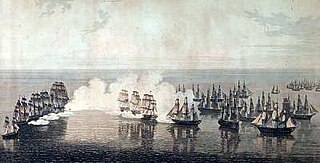Two vessels served the British East India Company (EIC) as East Indiamen named Alfred:

The East India Company (EIC), also known as the Honourable East India Company (HEIC) or the British East India Company and informally as John Company, Company Bahadur, or simply The Company, was an English and later British joint-stock company. It was formed to trade in the Indian Ocean region, initially with Mughal India and the East Indies, and later with Qing China. The company ended up seizing control over large parts of the Indian subcontinent, colonised parts of Southeast Asia, and colonised Hong Kong after a war with Qing China.
- Alfred (1772 EIC ship) was launched in 1772 and made four voyages for the EIC before she was sold in 1786 for hulking or breaking up.
- Alfred (1790 EIC ship) was launched in 1790 and made eight voyages for the EIC before she was sold in 1812 for hulking. In 1804 she engaged French warships during the Battle of Pulo Aura.
Alfred was launched in 1790 as an East Indiaman for the British East India Company (EIC). She made eight voyages for the EIC before she was sold. She participated in two notable incidents in which East Indiamen bluffed superior French naval forces from engaging. In January 1797, on her third voyage, in the Bali Strait Alfred and five other Indiamen sent off a French squadron of six frigates without a shot being fired. In February 1804, at Pulo Aura, during her sixth voyage she participated in a notable engagement with a French squadron. After her last voyage for the EIC Alfred served as a storeship and a hulk.

The Battle of Pulo Aura was a minor naval engagement of the Napoleonic Wars, fought on 14 February 1804, in which a large convoy of Honourable East India Company (HEIC) East Indiamen, well-armed merchant ships, intimidated, drove off and chased a powerful French naval squadron. Although the French force was much stronger than the British convoy, Commodore Nathaniel Dance's aggressive tactics persuaded Contre-Admiral Charles-Alexandre Durand Linois to retire after only a brief exchange of shot. Dance then chased the French warships until his convoy was out of danger, whereupon he resumed his passage toward British India. Linois later claimed that the unescorted British merchant fleet was defended by eight ships of the line, a claim criticised by contemporary officers and later historians.
Additionally, the following vessel made one voyage under charter to the EIC:
- Alfred (1818 ship) was launched at Chittagong in 1818 and between 1827 and 1828 made a voyage for the EIC as an "extra ship". In 1845 she was condemned but new owners restored her and named her Deutschland. She was last listed in 1857.
Alfred was launched at Chittagong in 1818 and in 1820 her owners transferred her registry to Great Britain. She then traded around India and between Britain and India under a license from the EIC. Between 1827 and 1828 made a voyage to China for the British East India Company (EIC) as an "extra ship", i.e., under charter. In 1845 she was condemned but new owners restored her and named her Deutschland. She was last listed in 1857.
| This article includes a list of ships with the same or similar names. If an internal link for a specific ship led you here, you may wish to change the link to point directly to the intended ship article, if one exists. |

